
Ants are eusocial insects of the family Formicidae and, along with the related wasps and bees, belong to the order Hymenoptera. Ants evolved from vespoid wasp ancestors in the Cretaceous period. More than 13,800 of an estimated total of 22,000 species have been classified. They are easily identified by their geniculate (elbowed) antennae and the distinctive node-like structure that forms their slender waists.

Leafcutter ants are fungus-growing ants that share the behaviour of cutting leaves which they carry back to their nests to farm fungus. Next to humans, leafcutter ants form some of the largest and most complex animal societies on Earth. In a few years, the central mound of their underground nests can grow to more than 30 m (98 ft) across, with smaller radiating mounds extending out to a radius of 80 m (260 ft), taking up 30 to 600 m2 and converted into 3.55 m individuals.

Carpenter ants are large ants indigenous to many forested parts of the world.

Habropoda laboriosa, the southeastern blueberry bee, is a bee in the family Apidae. It is native to the eastern United States. It is regarded as the most efficient pollinator of southern rabbiteye blueberries, because the flowers require buzz pollination, and H. laboriosa is one of the few bees that exhibit this behavior. It is active for only a few weeks of the year, while the blueberries are in flower during early spring, when the temperature is warm and humid. H. laboriosa are solitary bees that live alone but nest in close proximity with other nests of their species. They have similar features to bumble bees, but they are smaller in size compared to them. H. laboriosa are arthropods so they have segmented bodies that are composed of the head, thorax, and abdomen.
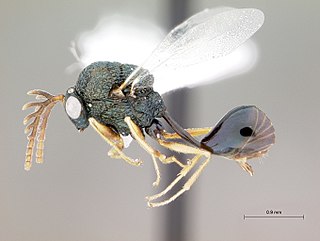
The Eucharitidae are a family of parasitic wasps. Eucharitid wasps are members of the superfamily Chalcidoidea and consist of four subfamilies: Akapalinae, Eucharitinae, Gollumiellinae, and Oraseminae. Most of the 42 genera and >400 species of Eucharitidae are members of the subfamilies Oraseminae and Eucharitinae, and are found in tropical regions of the world.
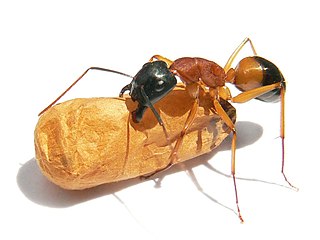
The banded sugar ant, also known as the sugar ant, is a species of ant native to Australia. A member of the genus Camponotus in the subfamily Formicinae, it was described by German entomologist Wilhelm Ferdinand Erichson in 1842. Its common name refers to the ant's liking for sugar and sweet food, as well as the distinctive orange-brown band that wraps around its gaster.

Nothomyrmecia, also known as the dinosaur ant or dawn ant, is an extremely rare genus of ants consisting of a single species, Nothomyrmecia macrops. These ants live in South Australia, nesting in old-growth mallee woodland and Eucalyptus woodland. The full distribution of Nothomyrmecia has never been assessed, and it is unknown how widespread the species truly is; its potential range may be wider if it does favour old-growth mallee woodland. Possible threats to its survival include habitat destruction and climate change. Nothomyrmecia is most active when it is cold because workers encounter fewer competitors and predators such as Camponotus and Iridomyrmex, and it also increases hunting success. Thus, the increase of temperature may prevent them from foraging and very few areas would be suitable for the ant to live in. As a result, the IUCN lists the ant as Critically Endangered.

The meat ant, also known as the gravel ant or southern meat ant, is a species of ant endemic to Australia. A member of the genus Iridomyrmex in the subfamily Dolichoderinae, it was described by British entomologist Frederick Smith in 1858. The meat ant is associated with many common names due to its appearance, nest-building behaviour and abundance, of which its specific name, purpureus, refers to its coloured appearance. It is among the best-known species of ant found throughout Australia; it occurs in almost all states and territories except for Tasmania. Its enormous distribution, aggression and ecological importance have made this ant a dominant species.

The green-head ant is a species of ant that is endemic to Australia. It was described by British entomologist Frederick Smith in 1858 as a member of the genus Rhytidoponera in the subfamily Ectatomminae. These ants measure between 5 and 7 mm. The queens and workers look similar, differing only in size, with the males being the smallest. They are well known for their distinctive metallic appearance, which varies from green to purple or even reddish-violet. Among the most widespread of all insects in Australia, green-head ants are found in almost every Australian state, but are absent in Tasmania. They have also been introduced in New Zealand, where several populations have been established.
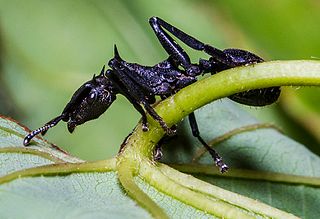
Cephalotes atratus is a species of arboreal ant in the genus Cephalotes, a genus characterized by its odd shaped head. These ants are known as gliding ants because of their ability to "parachute" by steering their fall if they lose their footing.

Acromyrmex versicolor is known as the desert leafcutter ant. A. versicolor is found during the summer months in the Colorado and Sonoran deserts when there is precipitation. They form large, distinctive nest craters that are covered with leaf fragments. Living and dead leaves are collected by workers and used to cultivate fungus gardens. Each colony can have multiple queens, if they do this is a practice called polygyny, and each queen has her own batch of “starter” fungus. This species does not sting.
Avitomyrmex is an extinct genus of bulldog ants in the subfamily Myrmeciinae which contains three described species. The genus was described in 2006 from Ypresian stage deposits of British Columbia, Canada. Almost all the specimens collected are queens, with an exception of a single fossilised worker. These ants are large, and the eyes are also large and well-developed; a sting is present in one species. The behaviour of these ants may have been similar to extant Myrmeciinae ants, such as foraging solitarily for arthropod prey and never leaving pheromone trails to food sources. Avitomyrmex has not been assigned to any tribe, instead generally being regarded as incertae sedis within Myrmeciinae. However, its identity as an ant has been challenged, although it is undoubtedly a hymenopteran insect.
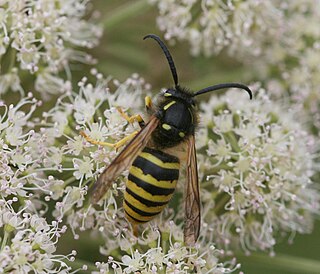
The tree wasp is a species of eusocial wasp in the family Vespidae, found in the temperate regions of Eurasia, particularly in western Europe. Despite being called the tree wasp, it builds both aerial and underground paper nests, and can be found in rural and urban habitats. D. sylvestris is a medium-sized wasp that has yellow and black stripes and a black dot in the center of its clypeus. It is most common to see this wasp between May and September during its 3.5 month colony cycle.

Dinoponera is a strictly South American genus of ant in the subfamily Ponerinae, commonly called tocandiras or giant Amazonian ants. These ants are generally less well known than Paraponera clavata, the bullet ant, yet Dinoponera females may surpass 3–4 cm (1.2–1.6 in) in total body length, making them among the largest ants in the world.
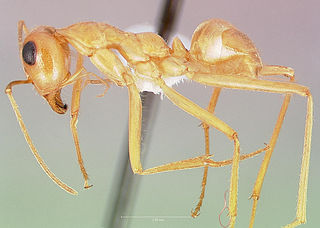
Myrmecocystus mexicanus is a species of ant in the genus Myrmecocystus, which is one of the six genera that bear the common name "honey ant" or "honeypot ant", due to curious behavior where some of the workers will swell with liquid food until they become immobile and hang from the ceilings of nest chambers, acting as living food storage for the colony. Honey ants are found in North America, Australia, and Africa. Ant species belonging to the genus Myrmecocystus reside in North America. M. mexicanus in particular is found in the southwestern United States and parts of Mexico.

Dilobocondyla is a genus of ants in the subfamily Myrmicinae. The genus is distributed in the Oriental and Australasian realms. It seems to be rare, with most species known only from single specimens.

Myrmecia regularis is a species of ant endemic to Australia. A member of the genus Myrmecia in the subfamily Myrmeciinae, it was first described by American entomologist Walter Cecil Crawley in 1925. These ants are medium to large in size, measuring 10 to 20 millimetres, and they are bright brownish-red in colour. Queens and workers share similar morphological features, but they can be distinguished by the noticeable size difference. Males also look similar, but collected specimens are too damaged to be examined properly.

Crematogaster carinata is a species of ant in the tribe Crematogastrini. It was first described by Gustav Mayr in 1862. It is native to Central and South America, where it is a common species, forming large colonies in the canopy of the forest.

Novomessor ensifer is a species of ant endemic to Mexico. A member of the genus Novomessor in the subfamily Myrmicinae, it was first described by Swiss entomologist Auguste Forel in 1899. N. ensifer was originally a part of the genus Aphaenogaster until a recent phylogenetic study concluded that Novomessor was genetically distinct and should be separated. The ant is a medium-sized species, measuring 5.5 to 10 millimetres. The ant is ferruginous-colored in some certain parts of the body, and small workers (nanitics) in incipient colonies are noticeably different in color and body structure.
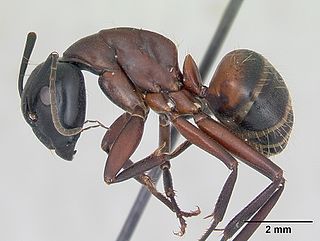
Camponotus ligniperda, the brown-black carpenter ant, is a common species of carpenter ant distributed widely throughout Europe. Found in a variety of woodland habitats, they commonly nest on the ground in dry tree stumps, dead fallen trees, or beneath stones and wooden logs that are partially buried. C. ligniperda is an ecologically dominant species wherever it is found due to both its large size and particularly aggressive nature.


















